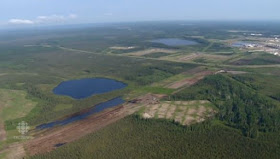It leaked 31,500 barrels of emulsion (1,323,000 gallons), a mixture of bitumen, water and sand.
JULY 17, 2015
CALGARY, Alberta —
Nexen Energy apologized on Friday for an oil sands pipeline leak in the Canadian province of Alberta that is one of North America’s largest-ever oil-related spills on land, and said its clean-up crews were working around the clock.
The subsidiary of China’s CNOOC Ltd. said it is still trying to find the root cause of the leak in the pipeline, which was new and installed last year. It found a visible breach about the size of a hand, which Nexen’s automatic detection systems did not pick up.
The incident is another blow for the environmental record of the oil sands industry, already under fire from environmental groups for its carbon-intensive production process.
“We are deeply concerned with this and we sincerely apologize for the impact,” said Ron Bailey, a senior vice president of Nexen who leads the company’s Canadian operations.
The spill was detected on Wednesday and leaked 31,500 barrels of emulsion, a mixture of bitumen, water and sand.
The leak covered 16,000 square meters and the Alberta Energy Regulator said it did not contaminate any water bodies. Nexen said the area has been isolated.
The volume is larger than the July 2010 rupture of an Enbridge Inc. pipeline which spilled an estimated 20,000 barrels of crude, with some reaching Michigan’s Kalamazoo River.
Still, because the spill was bitumen emulsion, rather than oil, it would be significantly easier to clean up and less damaging to the environment, said Raj Mehta, a professor of oil and gas engineering at the University of Calgary.
“It should not be contaminating any water table. Bitumen, because it’s so viscous, is like molasses,” he said. “You can literally backhoe and scoop it up.”
Alberta Premier Rachel Notley, who on Friday finalized a Canadian energy strategy with other provincial leaders, said the leak was “very troubling” but pipelines were still the best option for transporting crude oil.
“As much as everyone was concerned to hear it had happened, it did not actually in any way shake the conclusion by all premiers that pipelines remain the safest way to move hydrocarbon products,” said Notley, whose recently elected left-wing NDP government has pledged to toughen the province’s environmental standards.
Nexen said restarting the pipeline, which connects its 9,000 barrel per day Kinosis oil sands project to Long Lake, will take “some time.” Production from Kinosis will be shut in until the pipeline is repaired.
Long Lake, which has capacity of 72,000 bpd but is producing about 50,000 bpd, is 22 miles southeast of the oil sands hub of Fort McMurray.
The largest Alberta oil-related spill on record, according to the AER, was a 40,000 barrel-release from a pipeline operated by Peace Pipe Ltd. in December 1980. More recently, a Plains Midstream Canada pipeline failed in April 2011, releasing an estimated 28,000 barrels of oil in the northwestern part of the province.
JULY 17, 2015
CALGARY, Alberta —
Nexen Energy apologized on Friday for an oil sands pipeline leak in the Canadian province of Alberta that is one of North America’s largest-ever oil-related spills on land, and said its clean-up crews were working around the clock.
The subsidiary of China’s CNOOC Ltd. said it is still trying to find the root cause of the leak in the pipeline, which was new and installed last year. It found a visible breach about the size of a hand, which Nexen’s automatic detection systems did not pick up.
The incident is another blow for the environmental record of the oil sands industry, already under fire from environmental groups for its carbon-intensive production process.
“We are deeply concerned with this and we sincerely apologize for the impact,” said Ron Bailey, a senior vice president of Nexen who leads the company’s Canadian operations.
The spill was detected on Wednesday and leaked 31,500 barrels of emulsion, a mixture of bitumen, water and sand.
The leak covered 16,000 square meters and the Alberta Energy Regulator said it did not contaminate any water bodies. Nexen said the area has been isolated.
The volume is larger than the July 2010 rupture of an Enbridge Inc. pipeline which spilled an estimated 20,000 barrels of crude, with some reaching Michigan’s Kalamazoo River.
Still, because the spill was bitumen emulsion, rather than oil, it would be significantly easier to clean up and less damaging to the environment, said Raj Mehta, a professor of oil and gas engineering at the University of Calgary.
“It should not be contaminating any water table. Bitumen, because it’s so viscous, is like molasses,” he said. “You can literally backhoe and scoop it up.”
Alberta Premier Rachel Notley, who on Friday finalized a Canadian energy strategy with other provincial leaders, said the leak was “very troubling” but pipelines were still the best option for transporting crude oil.
“As much as everyone was concerned to hear it had happened, it did not actually in any way shake the conclusion by all premiers that pipelines remain the safest way to move hydrocarbon products,” said Notley, whose recently elected left-wing NDP government has pledged to toughen the province’s environmental standards.
Nexen said restarting the pipeline, which connects its 9,000 barrel per day Kinosis oil sands project to Long Lake, will take “some time.” Production from Kinosis will be shut in until the pipeline is repaired.
Long Lake, which has capacity of 72,000 bpd but is producing about 50,000 bpd, is 22 miles southeast of the oil sands hub of Fort McMurray.
The largest Alberta oil-related spill on record, according to the AER, was a 40,000 barrel-release from a pipeline operated by Peace Pipe Ltd. in December 1980. More recently, a Plains Midstream Canada pipeline failed in April 2011, releasing an estimated 28,000 barrels of oil in the northwestern part of the province.




